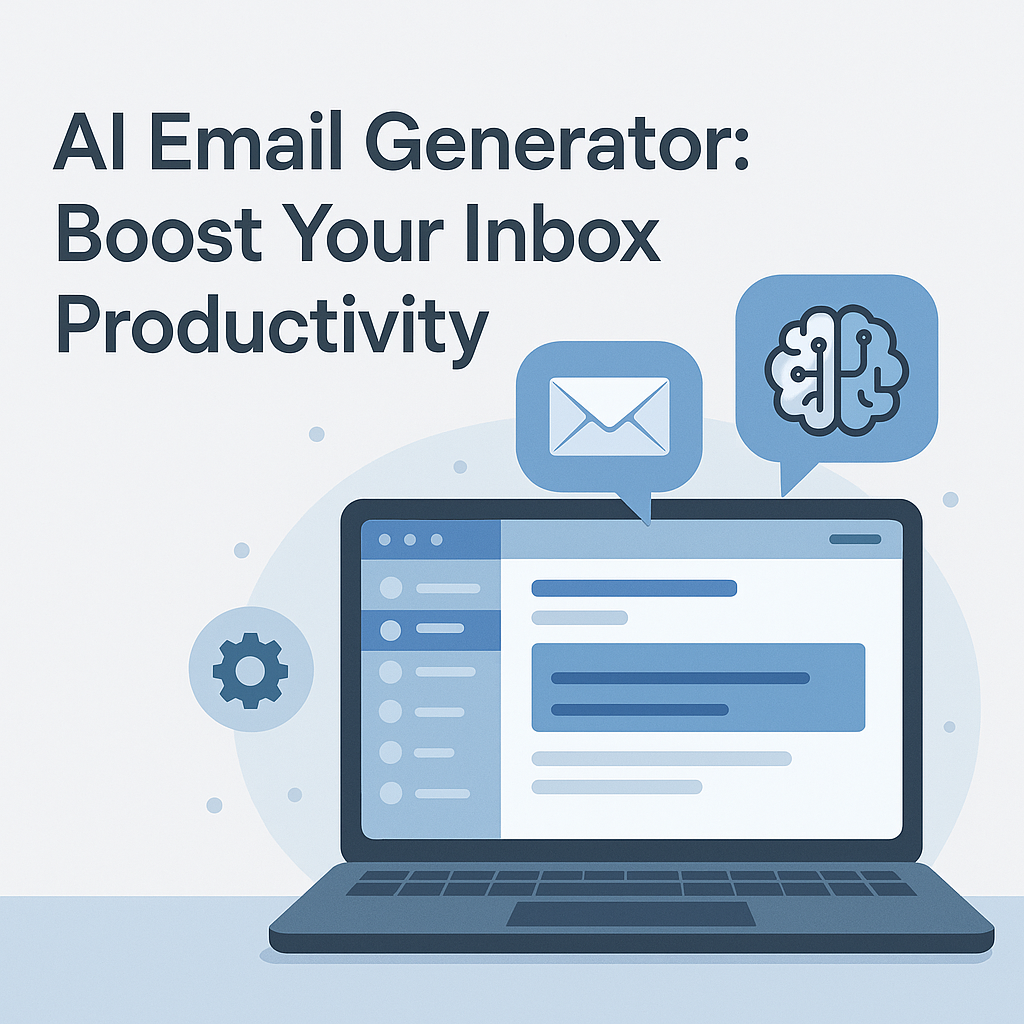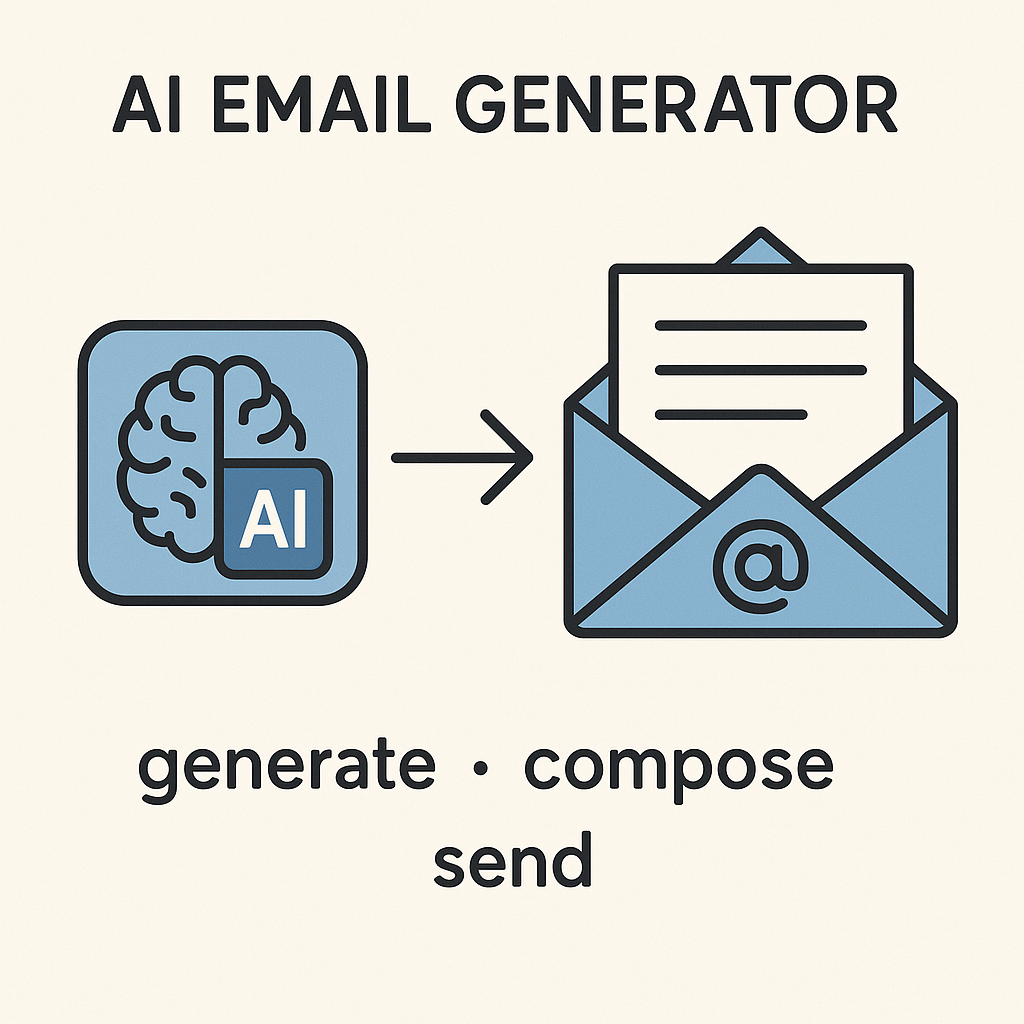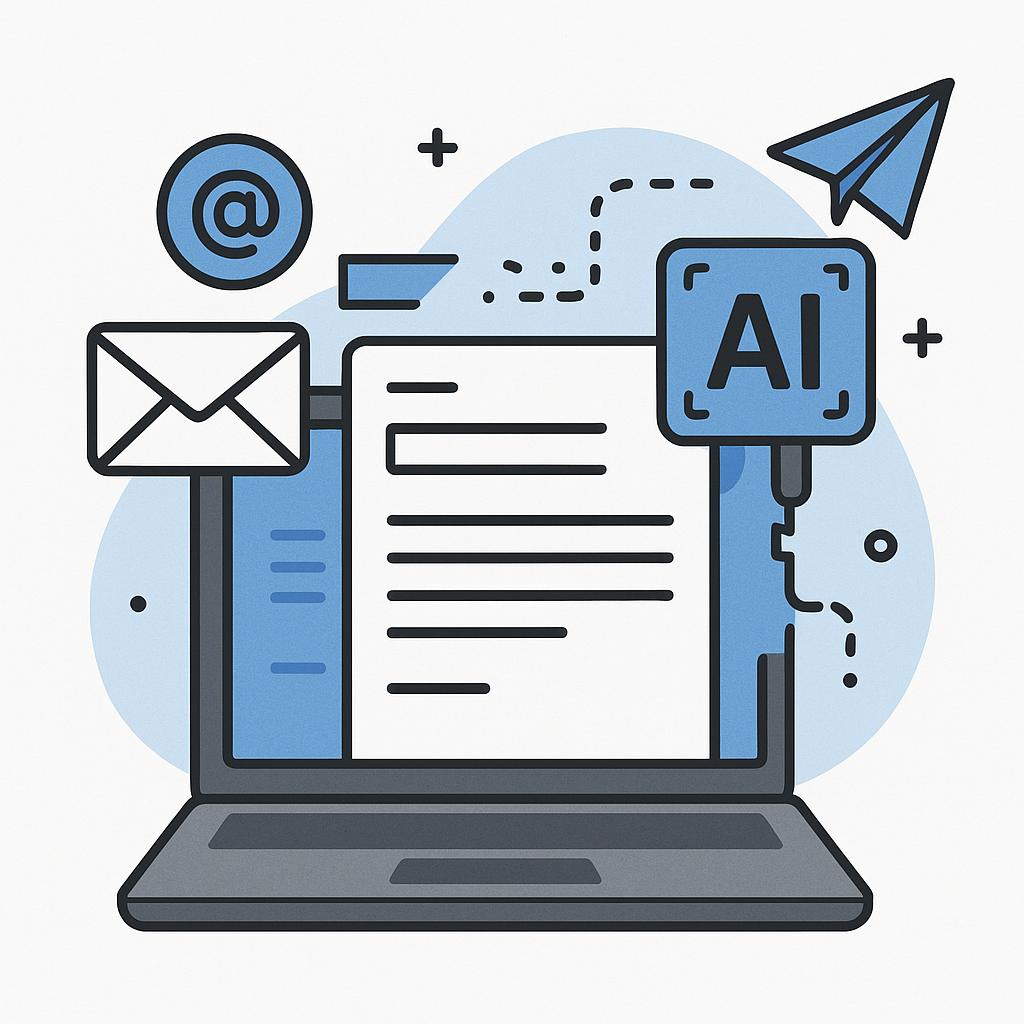AI Email Generator: Boost Your Inbox Productivity

Imagine this: It's Monday morning, and your inbox already has 100 unread messages. By lunchtime, that number has doubled. The sheer volume of emails professionals face daily is staggering, leading to what many describe as "email overload." This constant influx demands not only time but also significant cognitive effort to craft clear, professional, and effective responses. For busy executives, entrepreneurs, sales professionals, and remote workers alike, email management can easily consume hours that could otherwise be dedicated to strategic tasks, client engagement, or innovation. The pressure to maintain high-quality communication while juggling countless other responsibilities is immense. Fortunately, a powerful ally has emerged to help tackle this modern challenge: the ai email generator.
What is an AI Email Generator and How Does it Work?
At its core, an ai email generator is a sophisticated software tool designed to assist users in writing emails. Often functioning as a specialized AI writing assistant, these platforms leverage advanced artificial intelligence, particularly natural language processing (NLP) and large language models (LLMs). Unlike basic template builders or auto-complete features, AI email generators can understand context, generate coherent and contextually relevant text, and adapt to various writing styles and tones.
The technology behind these tools is fascinating. LLMs are trained on massive datasets of text and code, allowing them to learn grammar, syntax, writing styles, and even nuances of human communication. When you provide an input – whether it’s a few keywords, a brief description of the email's purpose, the desired tone, or even an existing email thread for context – the AI analyzes this information. It then predicts the most probable sequence of words to form a complete, professional, and effective email draft. Some advanced tools may also integrate with your existing email client or CRM to pull relevant information, enabling more personalized and efficient communication.
As Microsoft highlights regarding its AI email assistants, these tools can help organize messages, suggest replies, and prioritize important communications, effectively automating significant portions of the email management process. Toolsaday also points out that an AI Email Writer can be an innovative, free tool that saves time and effort in crafting professional emails quickly and accurately.
Key Benefits of Using AI Email Generators for Productivity
The adoption of an ai email generator offers a cascade of benefits that directly translate into enhanced productivity and improved communication quality. Let's explore the most significant advantages:
- Unprecedented Speed and Efficiency: Perhaps the most immediate benefit is the sheer speed at which emails can be drafted. Instead of staring at a blank screen for several minutes, an AI can generate a first draft in seconds. This transforms what could take 10-15 minutes of drafting and revising into a task completed in under a minute, saving professionals valuable hours each week.
- Enhanced Communication Quality: AI generators are trained on best practices in writing, grammar, and syntax. They can help produce clearer, more concise, and error-free emails, significantly reducing misunderstandings and ensuring a polished, professional image. This is crucial for effective AI for business communication.
- Consistent Tone and Brand Voice: Maintaining a uniform tone across all communications can be a challenge, especially for larger teams or businesses. AI tools can be prompted or configured to adhere to a specific brand voice, ensuring professionalism and brand integrity in every message, from marketing campaigns to customer support interactions.
- Significant Time Savings and Focus: By automating the initial drafting or suggesting smart email replies, these tools free up mental energy. Professionals can then focus on refining the message, adding personal insights, and strategizing rather than getting bogged down in the mechanics of writing. This directly contributes to overall email productivity tools.
- Adaptable Tone and Style: Need to sound formal for a client proposal? Friendly for a team update? Persuasive for a sales pitch? An AI can pivot its language to match the required tone and audience, making communication more effective and resonant. This capability is key for automate email responses efficiently and appropriately.
- Overcoming Writer's Block: For many, the most daunting part of email communication is simply starting. AI generators provide a solid, well-structured starting point, helping users overcome writer's block and get their ideas down quickly.
- Improved Engagement: Well-crafted, clear, and appropriately toned emails are more likely to be opened, read, and acted upon, leading to better engagement rates with clients, prospects, and colleagues.
Practical Use Cases: From Drafting to Follow-ups
The versatility of AI email generators means they can be applied across a wide range of professional scenarios. Here are some practical use cases:
- Drafting Initial Emails: Whether it's a customer inquiry, a networking request, a job application, or a project update, AI can generate a well-structured draft based on just a few key points or a brief outline.
- Generating `AI Sales Outreach` Sequences: Sales professionals can leverage AI to craft compelling cold outreach emails, personalized follow-up sequences, and effective responses to common objections. This drastically speeds up the process of engaging potential clients and nurturing leads. As discussed in our guide on [Email Lead Nurturing: AI for Growth & Revenue](/email-lead-nurturing-ai-growth-revenue), consistent and personalized outreach is key, and AI generators excel here.
- Crafting Follow-up Emails: Following up is critical but often time-consuming. AI can generate polite and effective follow-up emails for missed meetings, unanswered proposals, or pending actions, ensuring no opportunity slips through the cracks.
- Responding to Common Queries: For customer service and support roles, AI can draft accurate and helpful replies to frequently asked questions. This allows human agents to focus on more complex, sensitive, or unique customer issues, making it a prime example of how to automate email responses.
- Summarizing Long Email Threads: Some advanced tools can analyze lengthy email chains and provide a concise summary, helping users quickly grasp the main points without rereading multiple messages. This is invaluable for staying on top of ongoing projects or complex discussions.
- Subject Line Optimization: A compelling subject line is crucial for getting your emails opened. AI can suggest multiple subject line options, optimized for clarity, intrigue, and engagement, improving your open rates.
- Internal Communication: Drafting meeting agendas, project status reports, team announcements, or internal memos becomes significantly faster and more professional with AI assistance.
- Event Invitations and Confirmations: Quickly generate professional invitations, RSVP requests, and confirmation emails for meetings, webinars, or events.
Tools like WriteMail.ai are frequently cited for streamlining these processes, helping users maintain a consistent tone and style across all their co-authored emails.
Choosing the Right AI Email Generator for Your Needs
With the growing number of AI email tools available, selecting the right one can seem daunting. Here’s a guide to help you make an informed decision:
- Identify Your Primary Use Case: Are you focused on sales outreach, customer support, marketing, internal communications, or general daily productivity? Different tools excel in specific areas. For instance, if your goal is to boost AI sales outreach, look for tools with features tailored to that.
-
Evaluate Key Features: Consider the functionalities that matter most to you:
- Tone and Style Customization: Can you easily adjust the tone (e.g., formal, casual, empathetic, assertive) and specify stylistic preferences?
- Template Variety: Does it offer pre-built templates for common scenarios like follow-ups, introductions, or proposals?
- Integration Capabilities: Does it seamlessly integrate with your existing email management software (like Gmail, Outlook) or CRM?
- Grammar and Spell Check: Look for advanced, AI-powered proofreading tools.
- Contextual Understanding: How well does the AI grasp nuances from your prompts and existing conversation threads?
- Speed and Output Quality: Test its ability to generate relevant, high-quality content quickly. Tools like WriteMail.ai are praised for their speed and accuracy.
- Consider User Experience (UX): An intuitive interface makes adoption easier and the tool more pleasant to use daily. A clunky interface can negate the time-saving benefits.
- Pricing and Trials: Most services offer free trials or freemium models. Utilize these to test different tools and see which best fits your budget and workflow before committing to a subscription.
- Data Privacy and Security: For sensitive business communications, ensure the provider has robust security measures and clear data privacy policies. Understand how your data is used and protected.
- Scalability: As your needs grow, can the tool scale with you? Does it offer features for team collaboration or advanced customization?
For those seeking a comprehensive solution to manage not just email generation but the entire inbox ecosystem, consider the benefits of an ai executive assistant. These advanced platforms can offer integrated AI features for task management, scheduling, and communication oversight, providing a holistic approach to inbox efficiency.
Integrating AI Email Generators into Your Workflow
Simply acquiring an AI email generator isn't enough; effective integration into your daily routine is key to unlocking its full potential. Here’s how to do it:
- Start Small and Experiment: Don't try to overhaul your entire email process overnight. Begin by using the AI generator for specific, time-consuming tasks, like drafting initial outreach emails or responding to common inquiries. Gradually expand its use as you become more comfortable.
- Treat AI as a Co-Pilot, Not an Autopilot: AI-generated content is a powerful starting point, but it's rarely perfect out-of-the-box. Always review, edit, and personalize the output before sending. Add your unique insights, experiences, and a personal touch to ensure authenticity and build stronger relationships.
- Provide Clear and Specific Prompts: The quality of the AI's output directly depends on the quality of your input. Be specific with your prompts, clearly defining the purpose of the email, the intended audience, the desired tone, and any key information that must be included. The more context you provide, the better the result.
- Learn and Adapt Your Approach: Pay attention to which prompts yield the best results. Many AI writing assistant tools allow for custom instructions or style guides. Utilizing these features can further tailor the AI's output to your specific needs and preferences. Think of it like learning to use any new tool effectively; practice makes perfect.
- Combine with Other Productivity Tools: AI email generators work best when integrated into a broader productivity ecosystem. Pairing them with tools that help manage your schedule, tasks, or CRM can create a powerful synergy. For instance, using an AI assistant app that manages your to-do list alongside your email generator can create a highly efficient workflow. Discovering tools like the [Superhuman App: Boost Email Productivity with Competitor Insights](/superhuman-app-boost-email-productivity-with-competitor-insights) shows how specialized tools can complement AI assistance for a truly optimized experience.
- Establish Team Guidelines: If implementing AI tools within a team, establish clear guidelines on their usage, review processes, and brand voice consistency to ensure everyone is on the same page.
AI Email Generators vs. Traditional Email Management
Traditional email management often involves manual drafting, relying on pre-written templates stored in separate documents or email client features, and significant time spent on formatting, proofreading, and sending. While functional, this approach is inherently manual, prone to human error, can lead to inconsistencies in tone and brand voice, and is incredibly time-consuming, especially when dealing with high email volumes. If a situation deviates even slightly from a stored template, considerable manual editing is required, which is inefficient and can introduce mistakes.
AI email generators represent a paradigm shift. They move beyond static templates to dynamic, context-aware content creation. The differences are stark:
- Speed: AI generates content in seconds; manual drafting takes minutes or hours.
- Adaptability: AI can instantly adjust tone, style, and content based on prompts; manual methods require significant re-writing or searching for appropriate templates.
- Consistency: AI ensures brand voice adherence and grammatical correctness; manual methods can vary wildly between individuals and even within a single person's day.
- Efficiency: AI handles repetitive drafting tasks efficiently, freeing up human capacity for strategic thinking, personalization, and relationship building.
- Innovation: While traditional methods rely on existing tools, AI email generators are part of a growing wave of email productivity tools that leverage cutting-edge technology. Tools like an [Email Inbox Cleaner: Boost Productivity with Smart Triage](/email-inbox-cleaner-boost-productivity-with-smart-triage) help manage the incoming flow of messages, while AI generators handle the outgoing communication efficiently. This combination optimizes the entire email lifecycle, making it more manageable and productive.
The capabilities offered by AI are fundamentally transforming how professionals interact with their inboxes, moving from a chore-based system to a more strategic and efficient communication hub.
Conclusion: Embracing AI for Inbox Efficiency
In today's fast-paced business world, managing email effectively is paramount to success. The relentless tide of messages can easily overwhelm even the most organized professionals, leading to lost productivity and potential communication breakdowns. Fortunately, the advent of the ai email generator offers a powerful, transformative solution to this persistent challenge.
By automating the drafting process, enhancing communication quality, ensuring consistency, and saving invaluable time, these AI-powered tools empower individuals and teams to communicate more effectively and efficiently. From streamlining AI sales outreach and nurturing leads to providing smart email replies and ensuring consistent AI for business communication, the applications are vast and impactful. Embracing an ai email generator isn't about replacing human interaction; it's about augmenting human capabilities. It allows you to focus on strategy, relationship building, and the core tasks that truly drive your business forward, rather than getting bogged down in the minutiae of email composition.
Are you ready to reclaim your time, reduce inbox stress, and transform your communication? Start exploring the capabilities of an ai email generator today. Experiment with different tools, integrate them thoughtfully into your workflow, and experience the significant boost in productivity and communication quality firsthand. Your future, more efficient self will thank you.



